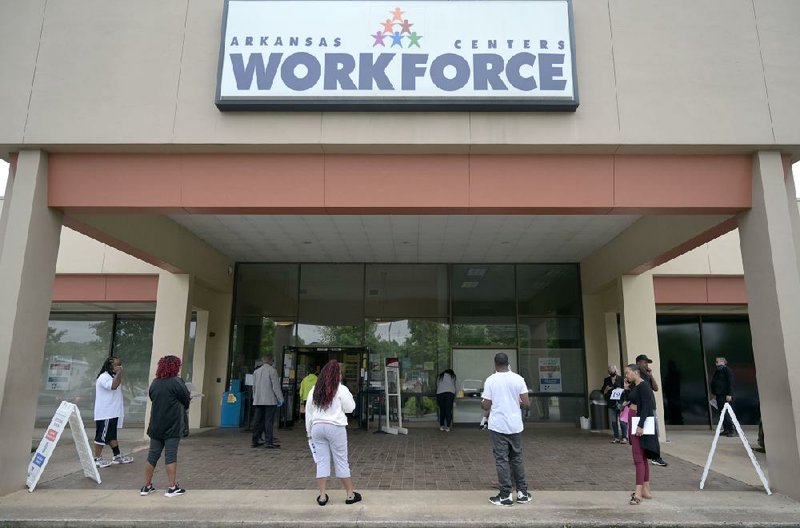Applications for states' unemployment benefits unexpectedly jumped last week to the highest since August and Americans increasingly moved to longer-term jobless aid.
Both are troubling signs for a labor market whose recovery from the pandemic was already slowing.
Initial jobless claims in regular state programs totaled 898,000 in the week ended Oct. 10, up 53,000 from the previous week, Labor Department data showed Thursday. On an unadjusted basis, the figure posted the largest one-week increase since July.
Continuing claims -- or total Americans claiming ongoing unemployment assistance in those programs -- fell 1.17 million to 10 million in the week ended Oct. 3.
But that may partially reflect people exhausting state aid and moving to Pandemic Emergency Unemployment Compensation, the federal program that provides up to 13 additional weeks of jobless benefits. Those claims rose by 818,054 to 2.78 million in the week ended Sept. 26, on an unadjusted basis.
[CORONAVIRUS: Click here for our complete coverage » arkansasonline.com/coronavirus]
Initial claims rose in more than half of U.S. states, pointing to broad-based head winds for the labor market and the economy as virus cases pick up again and colder weather starts to curb demand for outdoor dining.
The government also said 373,000 people applied for jobless aid under a separate program that made the self-employed, contractors and gig workers eligible for unemployment benefits for the first time. That figure was 90,000 lower than in the previous week. These figures aren't adjusted for seasonal trends, so the government reports them separately from the traditional jobless claims.
The numbers highlight the risk that October figures will show a decline in payrolls after September's 661,000 jobs gain that was the slowest of the pandemic recovery.
"I think we've seen the labor market recovery stall out," said Sarah House, senior economist at Wells Fargo & Co. Given that jobless claims can be volatile even in normal times, it's not yet certain that the jobs rebound is reversing, "but I think we've seen a heightened risk of the labor market really backsliding," she said.
SKEWED BY CALIFORNIA DATA
California, which typically accounts for about one-fourth of the nation's jobless-aid applications, has reported the same number of claims for several weeks as a placeholder. That's because it temporarily stopped processing new applications while it implements anti-fraud technology and clears a backlog of claims.
That means jobless claims rose nationally last week even though they were unchanged in the largest state. Applications rose significantly in 17 states, including Florida, Georgia, Illinois, Indiana, Massachusetts and Washington. In Wisconsin, they increased by a quarter to nearly 15,000.
For the extended Pandemic Emergency Unemployment Compensation aid, whose figures come with a two-week lag, claims surged in many states and particularly in California, New York, Michigan and Pennsylvania.
That suggests the next jobs report will show further increases in long-term unemployment; the September figures showed 781,000 people joined the ranks of those who have been jobless for 27 weeks or longer, the biggest monthly increase on record. Most states offer 26 weeks of benefits.
The supplemental $600 a week in jobless benefits authorized by the Coronavirus Aid, Relief, and Economic Security Act in late March expired in July, and since then lawmakers have been at a stalemate over another large stimulus bill. Funds have been drying up in a stopgap benefits program authorized by President Donald Trump, and the extended Pandemic Emergency Unemployment Compensation aid will expire at the end of December unless Congress acts.
However, with less than three weeks until the Nov. 3 presidential election, an agreement is increasingly in doubt, adding risks that declining income will weigh on consumer spending.
'LONG-TERM DAMAGE'
Nationwide, on average, unemployment benefits replace about 33% of what recipients earned at their previous job. That is down from 36% in 2009.
"As we see more and more people shift to the ranks of the long-term unemployed, it suggests that this is not going to be nearly as quick of a downturn and that there is going to be long-term damage that results from what otherwise looks like a pretty short recession," said House of Wells Fargo.
Fraud and issues around double-counting claims have caused many economists to take a more skeptical view of whether jobless aid applications are a precise barometer of layoffs. But most still see an increase in claims as a discouraging sign even if the level may be inflated by people who have filed a number of applications for different programs.
The end of federal aid for the unemployed will likely force many of the jobless to sharply cut their spending, thereby weakening the economy. The full impact may have been delayed, though, by the fact that most of the federal aid was saved or was used to pare debt, according to research by the Federal Reserve Bank of New York.
According to the New York Fed, at the end of June nearly one-quarter of jobless aid payments had been saved. Nearly half were used to pay down debt. Just 28% of the money was spent.
And more than one-third of the $1,200 stimulus checks that went to most adults was saved, with an additional one-third of that money used to pay off debt.
Thursday's unemployment report is among a string of poor economic news, with headlines punctuated with reports of large companies announcing layoffs in recent weeks.
These companies include Disney, insurance company Allstate, American and United Airlines, Aetna, and Chevron.
"It's not coming down quickly," said Julia Pollak, a labor economist at the jobs site ZipRecruiter. "It's unclear how quickly we can recover. We're likely to see additional layoffs and high numbers of unemployment for the foreseeable future."
Information for this article was contributed by Reade Pickert, Edith Moy and Sophie Caronello of Bloomberg News; by Christopher Rugaber of The Associated Press; and by Eli Rosenberg of The Washington Post.

